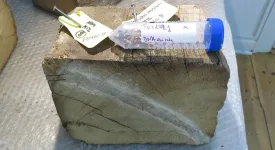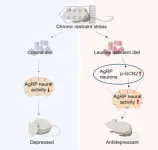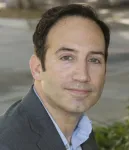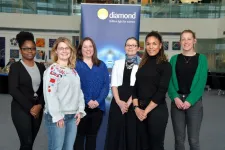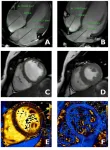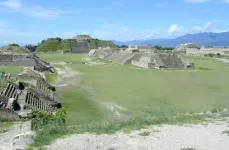An interdisciplinary solution for enhanced high-resolution imaging in electron and optical microscopy
A new ghost imaging algorithm improves resolution and contrast
2023-03-03
(Press-News.org)
Although electron microscopy can already reveal details as small as one nanometer, ongoing research seeks to break through barriers limiting image quality and reducing the optical dose on the samples. Aberration is a common problem in electron microscopy that can reduce the resolution and quality of the images produced. Additional complex phase and amplitude controls are needed in these microscopes. An international team of researchers led by Akhil Kallepalli (Kallepalli Lab) working within the Optics Group at the University of Glasgow set out to address the problem. Working from an optics perspective, they developed and tested a new ghost imaging algorithm, finding that they could produce an image with improved resolution and contrast using lower flux illumination, which could reduce sample damage.
The research was published Dec. 21 in Intelligent Computing, a Science Partner Journal.
Optical modulation is required to achieve better control of illumination strategies. Modulation in optics is the process of varying the properties of light waves to encode information. It is used in optical communication systems and in various applications, such as spectroscopy and imaging. Modulators of many kinds have long been available in the field of optics.
However, modulators are not available for electron microscopy. It is still challenging to achieve complex phase and amplitude control to reduce phase aberration for continuous imaging enhancement in the field of electron microscopy.
The authors applied computational ghost imaging, an optical approach, to electron microscopy and designed a new algorithm to address this problem. The approach inverts knowledge of the projected patterns and their measured transmission to reconstruct the image. This can be used to measure the transmittance of the sample when illuminated with more complex spatial patterns. In this system, the resulting form of the light field in the plane of the object can be calculated using numerical beam propagation techniques enabling both lens-free and far-field implementations. Therefore, computational ghost imaging can be used for transmission electron microscopy imaging.
In optical methods, spatial light modulators can be used to ensure the orthogonality of the imaging patterns. It is, however, difficult to guarantee orthogonality between patterns when using natural scattering or highly limited modulators. This new algorithm designed by the authors makes optimal use of patterns regardless of their orthogonality. They call their new method “orthogonalized ghost imaging.”
The authors tested their method in two ways. First, they conducted an optical experiment analogous to the transmission electron microscopy system. This experiment tested the illumination strategy and the algorithm’s robustness to non-orthogonality. After that, they tested their method with transmission electron microscopy.
The experiments showed that the authors’ ghost imaging algorithm produces a higher-resolution image reconstruction with better contrast in comparison to the most common online ghost imaging algorithm. The new algorithm enhances the imaging capabilities at any wavelength, and is robust to the non-orthogonality of the pattern sets, enabling effective application in both optical and electron microscopy. In an appendix to their paper, the authors highlight some findings relating to electron microscope sample damage, which could be reduced using their method. Future development can be used to further optimize imaging resolution or speed across both optical and electron microscopic imaging.
Kallepalli’s co-authors are Lorenzo Viani, Enzo Rotunno, Paolo Rosi, Stefano Frabboni and Vincenzo Grillo of CNR-NANO, Modena, Italy; Daan Stellinga of the University of Twente, Enschede, The Netherlands; Richard Bowman, Graham M. Gibson and Miles J. Padgett of the University of Glasgow, Scotland; Ming-Jie Sun of Beihang University, Beijing; and Roberto Balboni and Andrea Migliori of CNR-IMM, Bologna, Italy.
This research was funded in part by the European Union’s Horizon 2020 Research and Innovation Programme, the Royal Society EPSRC Research Council and the National Natural Science Foundation of China.
END
ELSE PRESS RELEASES FROM THIS DATE:
2023-03-03
Tree-ring analysis – so-called dendrochronological analysis – has been part of archaeology for many years and has made it possible for archaeologists to date old wooden objects with great precision. And in many cases, they have also been able to determine the provenance of the wood.
But it has proven difficult for researchers to determine timber’s place of origin when the historic timber was imported into Denmark from further afield to serve as building material.
In a new study in the journal PLOS ONE, Associate Professor Aoife Daly and Dr Alicia Van Ham-Meert from the University of Copenhagen show that combining analyses of ...
2023-03-03
Depression is a leading cause of disability around the world and contributes greatly to the global burden of disease. Nutrition is essential for the maintenance of normal emotional states. Nutritional therapy is rising up in many disease treatments, but little is known in the depression field. Unbalanced nutrition is implicated in the etiology of depression, potentially hindering treatment. For example, many essential amino acids (EAAs) in serum are changed in patients with depression, such as tryptophan, threonine, leucine, isoleucine, and valine. However, whether EAA contributes to depression ...
2023-03-03
Public and private sector health officials and public policymakers should team up immediately with community leaders to more effectively disseminate accurate narratives regarding the life-saving benefits of vaccines to counter widespread, harmful misinformation from anti-vaccine activists.
Such is the message of a UC Riverside-led viewpoint piece published Thursday, March 2, in the leading international medical journal, The Lancet.
“We need to consistently amplify the best science and find the best ways of communicating so that people are hearing it through multiple channels instead of through one or two sources,” ...
2023-03-03
Today, at the prestigious AAAS science conference in Washington DC, Diamond Light Source, the UK’s synchrotron science facility, will unveil plans for its biggest recruitment campaign since its inception 20 years ago. Dozens of new roles will be available in the coming year and some examples of the variety of STEM careers will be showcased and celebrated by an all-women line up from the Diamond team. This recruitment drive aims to ensure the facility has the knowledge and expertise required to help plan and deliver world leading science for the next decade and beyond
In the lead up to ...
2023-03-03
Magnetic resonance imaging (MRI) has allowed scientists at the Centro Nacional de Investigaciones Cardiovasculares (CNIC) to produce an accurate picture of the healthy heart in adolescence. Using this advanced technology, the research team was able to determine reference values for anatomical and functional parameters in the heart during adolescence. This information, pubished in eClinicalMedicine, has direct implications for clinical practice.
“Magnetic resonance imaging has become a very important method for studying the heart because it avoids exposing patients to radiation ...
2023-03-03
Some cities only last a century or two, while others last for a thousand years or more. Often, there aren’t clear records left behind to explain why. Instead, archaeologists piece together clues from the cities’ remains to search for patterns that help account for why certain places retained their importance longer than others. In a new study published in the journal Frontiers in Ecology and Evolution, researchers examined 24 ancient cities in what’s now Mexico and found that the cities that lasted the longest showed indications of collective forms of governance, infrastructural investments, and cooperation between households.
“For years, my colleagues and I have ...
2023-03-03
The Coalition for Trust in Health & Science today announced its formation and public launch during the 2023 American Association for the Advancement of Science (AAAS) Annual Meeting in Washington, D.C. The alliance was formed to unite leading organizations from across the entire health ecosystem to advance trust and factual science-based decision-making. The partnership aims to achieve a measurable increase in the public’s willingness – and ability – to access evidence-based information necessary to make the best personally appropriate health decisions for themselves, their ...
2023-03-03
When asteroids suffer natural impacts in space, debris flies off from the point of impact. The tail of particles that form can help determine the physical characteristics of the asteroid. NASA’s Double Asteroid Redirection Test mission in September 2022 gave a team of scientists including Rahil Makadia, a Ph.D. student in the Department of Aerospace Engineering at the University of Illinois Urbana-Champaign, a unique opportunity—to observe the evolution of an asteroid’s ejecta as it happened for the first time.
“My work on this mission ...
2023-03-03
BOSTON – Although investigators have made strides in detecting signs of Alzheimer’s disease using high-quality brain imaging tests collected as part of research studies, a team at Massachusetts General Hospital (MGH) recently developed an accurate method for detection that relies on routinely collected clinical brain images. The advance could lead to more accurate diagnoses.
For the study, which is published in PLOS ONE, Matthew Leming, PhD, a research fellow at MGH’s Center for Systems Biology and an investigator at the Massachusetts Alzheimer’s Disease Research Center, and his colleagues used deep learning—a type of machine learning ...
2023-03-03
Irvine, Calif., March 2, 2023 — Carbon dioxide emissions from wildfires, which have been gradually increasing since 2000, spiked drastically to a record high in 2021, according to an international team of researchers led by Earth system scientists at the University of California, Irvine.
Nearly half a gigaton of carbon (or 1.76 billion tons of CO2) was released from burning boreal forests in North America and Eurasia in 2021, 150 percent higher than annual mean CO2 emissions between 2000 and 2020, the scientists reported in a paper in Science.
“According to our measurements, boreal fires in 2021 shattered previous ...
LAST 30 PRESS RELEASES:
[Press-News.org] An interdisciplinary solution for enhanced high-resolution imaging in electron and optical microscopy
A new ghost imaging algorithm improves resolution and contrast
